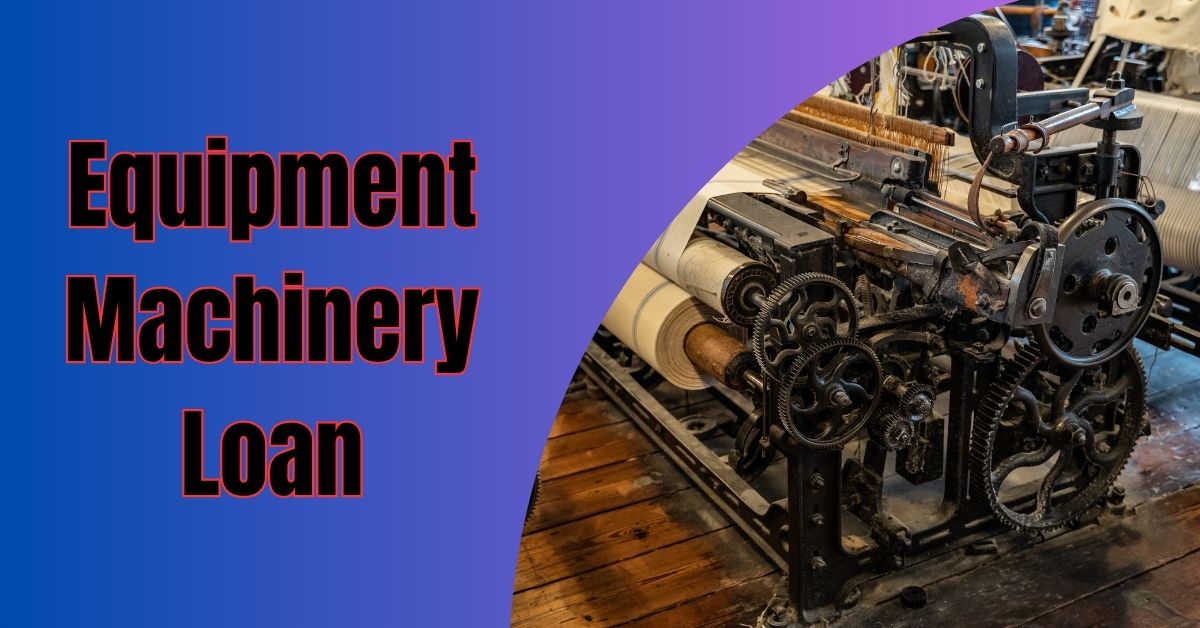Navigating the Complexities of Business Loans for Machinery and Equipment

Acquiring the right machinery or equipment is often crucial for a business’s growth, productivity, and competitiveness. However, the cost of these assets can be substantial, making it difficult for many small and medium-sized businesses to make such purchases outright.
This is where business loans for machinery and equipment come into play. These loans offer an opportunity to finance the purchase of essential equipment, allowing businesses to continue operations without depleting their cash reserves.
While obtaining a business loan for machinery might seem straightforward, the process can be complex, with various factors to consider, such as loan terms, types of loans, eligibility criteria, and repayment options.
In this blog, we’ll guide you through the complexities of securing a business loan for machinery and equipment and help you make an informed decision.
Types of Loans for Machinery and Equipment
When looking for a loan to purchase machinery or equipment, understanding the different types of loans available is crucial. Here are the most common loan options:
1. Term Loans
Term loans are the most traditional form of financing. With a term loan, a business borrows a lump sum of money to be repaid over a set period, usually with a fixed interest rate. These loans are ideal for purchasing machinery because the equipment itself can often serve as collateral. Term loans generally come with long repayment terms, ranging from one to five years, and are suited for businesses that need a substantial amount of funding.
2. Equipment Financing
Specifically designed for purchasing machinery, equipment financing loans allow businesses to borrow funds to purchase equipment, with the machinery itself acting as collateral. If the business fails to repay the loan, the lender can repossess the equipment. This option tends to have lower interest rates and flexible repayment schedules, making it one of the most common methods for acquiring machinery.
3. SBA 7(a) Loan
For U.S.-based businesses, the Small Business Administration (SBA) offers the 7(a) loan, which is popular among small businesses seeking to purchase machinery or equipment. The SBA guarantees a portion of the loan, making it less risky for lenders, which often results in lower interest rates and better repayment terms. SBA loans are suitable for businesses with a strong credit history and a proven track record.
4. Lease Financing
Leasing is another option, especially for businesses that may not want to commit to owning the equipment outright. In this case, the business essentially rents the machinery for a fixed period, with an option to buy at the end of the lease term. Lease financing is often more flexible than loans, but it doesn’t offer the same ownership benefits. It’s ideal for businesses that only need machinery for a limited time or that prefer to upgrade equipment frequently.
Key Factors to Consider Before Applying for a Business Loan
Securing a loan for machinery and equipment requires more than just finding a lender and filling out an application. Several factors should be taken into account to ensure you get the best possible deal for your business:
1. Loan Amount
The first step is to determine how much funding you need. Be realistic about the total cost of the machinery or equipment you want to purchase, factoring in additional costs such as delivery, installation, maintenance, and insurance. Understanding your funding needs will help you choose the right loan amount and avoid over-borrowing or under-borrowing.
2. Interest Rates and Fees
Interest rates are one of the most significant expenses associated with loans. It’s essential to compare rates from different lenders to ensure you’re getting the best deal. Keep in mind that the type of loan, your credit score, and the loan term will all influence the interest rate. In addition to interest, lenders may charge processing fees, late payment fees, or prepayment penalties, so be sure to factor those into your decision.
3. Repayment Terms
Repayment terms vary based on the lender and loan type. Some loans may require monthly payments, while others may offer more flexible options, such as quarterly payments or deferred payments for a few months. When selecting a loan, it’s important to consider your business’s cash flow and choose a repayment schedule that aligns with your ability to repay.
4. Collateral Requirements
For equipment loans, the machinery or equipment being purchased typically acts as collateral. However, some lenders may require additional collateral, such as business assets or personal guarantees, to secure the loan. If your business doesn’t have sufficient collateral or you’re unsure about this requirement, it’s worth exploring unsecured loans, although they may come with higher interest rates.
5. Credit Score and Financial History
Your business’s credit score is one of the most important factors lenders will consider when approving a loan. A higher credit score generally means better loan terms, including lower interest rates. If your credit score is less than stellar, it’s still possible to secure a loan, but you may face higher interest rates or be required to provide collateral.
Steps to Apply for a Business Loan for Machinery
Once you’ve decided on the type of loan and considered the necessary factors, the next step is to apply. Here’s a step-by-step guide:
- Evaluate Your Needs: Determine exactly what equipment you need and how much it will cost, including any additional expenses.
- Check Your Eligibility: Ensure that your business meets the lender’s requirements, including a good credit history, stable cash flow, and a solid business plan.
- Gather Documentation: Most lenders will require documents such as financial statements, tax returns, proof of ownership of the business, and details of the machinery you plan to purchase.
- Compare Lenders: Shop around for the best terms by comparing interest rates, repayment terms, and fees from different lenders, including banks, online lenders, and specialized equipment financing companies.
- Submit Your Application: Complete the loan application with the necessary documents and submit it to your chosen lender.
- Review the Terms: Once approved, carefully review the loan terms, including the interest rate, repayment schedule, and any associated fees, before signing the agreement.
Conclusion
Securing a business loan for machinery and equipment is a strategic move that can help businesses grow and stay competitive in their industry. However, navigating the complexities of these loans requires a clear understanding of the available options, loan terms, and application process.
By considering factors like interest rates, collateral requirements, and repayment terms, businesses can choose the best financing solution for their needs and ensure they’re making a sound investment in their future.
More Posts – Click Here




